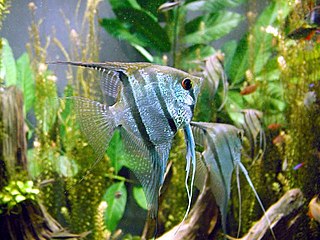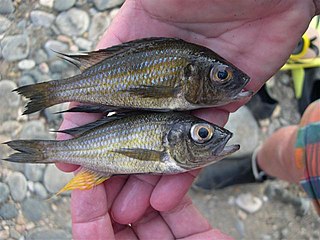
Cichlids are fish from the family Cichlidae in the order Cichliformes. Cichlids were traditionally classed in a suborder, the Labroidei, along with the wrasses (Labridae), in the order Perciformes, but molecular studies have contradicted this grouping. The closest living relative of cichlids is probably the convict blenny, and both families are classified in the 5th edition of Fishes of the World as the two families in the Cichliformes, part of the subseries Ovalentaria. This family is both large and diverse. At least 1,650 species have been scientifically described, making it one of the largest vertebrate families. New species are discovered annually, and many species remain undescribed. The actual number of species is therefore unknown, with estimates varying between 2,000 and 3,000.

Mouthbrooding, also known as oral incubation and buccal incubation, is the care given by some groups of animals to their offspring by holding them in the mouth of the parent for extended periods of time. Although mouthbrooding is performed by a variety of different animals, such as the Darwin's frog, fish are by far the most diverse mouthbrooders. Mouthbrooding has evolved independently in several different families of fish.

Pseudocrenilabrus is a genus of fish in the family Cichlidae, commonly known as the mouthbrooders endemic to rivers and lakes in Central and Eastern Africa.

Aulonocranus dewindti is a species of cichlid endemic to Lake Tanganyika and some rivers which flow into it.

Nimbochromis livingstonii, Livingston's cichlid or (locally) kalingono, is a freshwater mouthbrooding cichlid native to Lake Malawi, an African Rift Lake. It is also found in the upper Shire River and Lake Malombe. They are found in inshore areas of the lake over sandy substrates.

Ctenochromis horei is a species of haplochromine cichlid which is found in East Africa.
Astatotilapia flaviijosephi, the Jordan mouthbrooder, is a vulnerable species of freshwater fish in the family Cichlidae (cichlids). It is found in the central Jordan River system, including Lake Tiberias (Kinneret), in Israel, Jordan and Syria, making it the only haplochromine cichlid to naturally range outside of Africa. This species is too small to be of significant importance to fisheries, unlike the only other cichlids native to the Levant, the economically important tilapias.

The Lake Tanganyika sardine is a species of freshwater fish in the family Clupeidae which was endemic to Lake Tanganyika but which has now been introduced to other lakes in Africa as a food source. It is monotypic within the genus Limnothrissa. It and the Lake Tanganyika sprat are known collectively as kapenta.

The Egyptian mouthbrooder is a species of cichlid. This small mouthbrooder reaches about 8 cm (3.1 in) in length, and is found in rivers, lakes, and other freshwater habitats in Eastern Africa from Egypt and as far south as Tanzania. The common name Egyptian mouthbrooder was often limited to its northern nominate subspecies, in which case the southern P. m. victoriae is called the dwarf Victoria mouthbrooder. These subspecies are not universally regarded as valid.

Chromidotilapia guntheri, or Günther's mouthbrooder, is a cichlid from Africa. It was previously considered to consist of two subspecies, the common C. g. guntheri ranges from Liberia to Equatorial Guinea and Niger, and the critically endangered C. g. loennbergi which was thought to be restricted to Lake Barombi-ba-Kotto, a small crater lake in Cameroon but these subspecies are not supported by subsequent authorities. The species is noted for being a biparental mouthbrooder. Eggs are laid on a flat open surface and taken in the parents' mouth. Unlike many mouthbrooding cichlid species, both parents participate in the mouthbrooding.

Lamprologini is a tribe of African cichlid fishes. It contains seven genera and nearly 100 species. Over half of the species in this tribe are in the large genus Neolamprologus. Most genera in the tribe are endemic to Lake Tanganyika, but one species of Neolamprologus is from the Malagarasi River in Tanzania, and several species of Lamprologus are from the Congo River Basin.

The mango tilapia is a species of fish from the cichlid family that is native to fresh and brackish waters in Africa and the Levant. Other common names include Galilaea tilapia, Galilean comb, Galilee St. Peter's fish, and St. Peter's fish.. This is a relatively large cichlid at up to 41 centimetres (16 in) in total length and about 1.6 kilograms (3.5 lb) in weight. It is very important to local fisheries and the species is also aquacultured.

Pseudocrenilabrus nicholsi is a species of cichlid native to the Congo Basin in Africa. As other members of the genus Pseudocrenilabrus, it is a mouthbrooder. This species can reach a length of 8.5 centimetres (3.3 in) SL. The specific name honours the American ichthyologist John Treadwell Nichols (1883–1958) who was curator of fishes at the American Museum of Natural History. Nichols originally described this species as Paratilapia ventralis in 1928 but this name had already been used by George Albert Boulenger for another species of cichlid in 1898.

Tilapia sparrmanii, the banded tilapia, or vlei kurper, is a widespread and adaptable cichlid fish that is found in warmer freshwater habitats of southern Africa. They prefer water with ample plant cover, and occur naturally as far north as DR Congo and Tanzania. They have been introduced locally in the northern hemisphere. Younger banded tilapia feed on crustaceans and insect larvae, while the adults feed on terrestrial and aquatic plants and other debris. They undertake local migrations and may shoal before and during spawning time. They guard their own eggs, and although they may move eggs or fry in the mouth, they are not known to be actual mouthbrooders like several other tilapia species. This species can reach a length of 23.5 centimetres (9.3 in) TL and is an important foodfish.
The Mooi River is a river in North West Province, South Africa. It is a tributary of the Vaal River and belongs to the Upper Vaal Water Management Area.

Cichlidogyrus is a genus of monopisthocotylean monogeneans in the family Ancyrocephalidae. The type-species of the genus is Cichlidogyrus arthracanthusPaperna, 1960, by original designation. All the species of the genus are parasites on the gills of fish, namely African Cichlidae, Nandidae and Cyprinodontidae.

The redbelly tilapia, also known as the Zille's redbreast tilapia or St. Peter's fish, is a species of fish in the cichlid family. This fish is found widely in fresh and brackish waters in the northern half of Africa and the Middle East. Elsewhere in Africa, Asia, Australia and North America, it has been introduced as a food fish or as a control of aquatic vegetation. Where introduced, it sometimes becomes invasive, threatening the local ecology and species. The redbelly tilapia is an important food fish and sometimes aquacultured.
Pseudocrenilabrus pyrrhocaudalis, the fire-tailed pseudocrenilabrus, is a newly described species of small mouth-brooding haplochromine cichlid from Lake Mweru in south west central Africa. Its specific name is descriptive of its bright flame coloured orange tail in the breeding males which distinguishes it from the more widespread Pseudocrenilabrus philander.

Cichlidogyrus philander is a species of Monopisthocotylean Monogenean, in the family Ancyrocephalidae. It is ectoparasitic on the gills of the fish Pseudocrenilabrus philander.

Hemichromis letourneuxi is a species of cichlid which is native to West Africa and is popular in the aquarium hobby and it has been introduced to the Caribbean and the south-east United States where it is invasive.

















